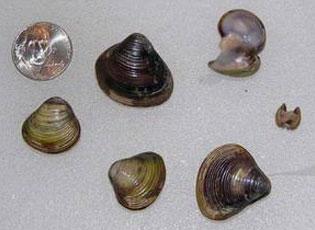Corbicula fluminea (O. F. Müller, 1774) (ITIS)
Asian clam, Asiatic clam
Asia, Africa, and Australia (Sousa et al. 2008)
First discovered in 1938 in Washington State (Foster et al. 2012)
Possibly imported as a food source (Sousa et al. 2008)
Reproduces in large colonies that can clog waterways and pipes (Foster et al. 2012)
Widespread throughout freshwater and some estuarine habitats in the U.S.

Asian clams, adult
Photo by Shawn Liston; Audubon of Florida
Find more images
Spotlights
Distribution / Maps / Survey Status
Videos
All Resources
Selected Resources
The section below contains highly relevant resources for this species, organized by source.
Council or Task Force
Partnership
Federal Government
State and Local Government
Academic
Integrated Taxonomic Information System. Corbicula fluminea. [Accessed Mar 12, 2023].
Nonindigenous Aquatic Species Database. Fact Sheet - Asian Clam. USGS, Gainesville, FL. [Accessed Mar 12, 2023].
Sousa, R., C. Antunes, and L. Guilhermino. 2008. Ecology of the invasive Asian clam Corbicula fluminea (Müller, 1774) in aquatic ecosystems: an overview. International Journal of Limnology 44(2):85-94.
